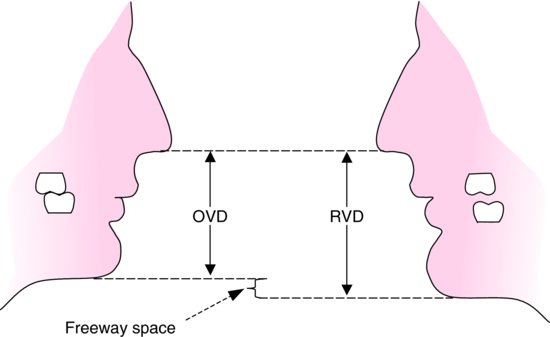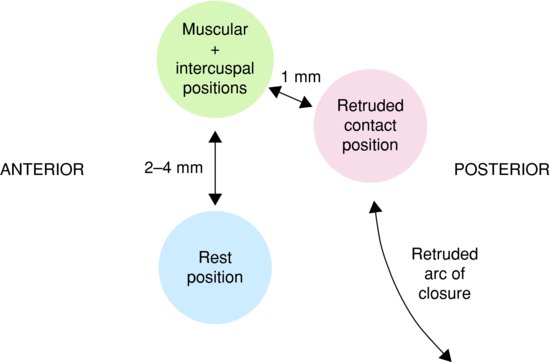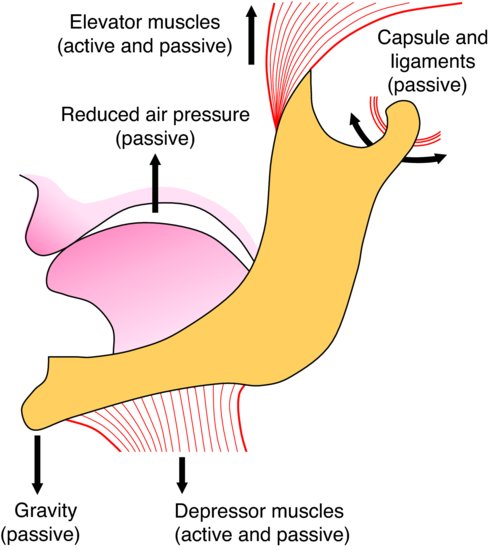5
Jaw Relations – Theoretical Considerations
The clinical procedure of recording the jaw relationship enables the clinician to provide the dental technician with the following information:
- An appropriate vertical and horizontal relationship of the mandible to the maxilla.
- The required shape of the dentures.
This information is given to the dental technician in the form of wax record rims, which have been adjusted by the clinician, to enable the casts to be mounted on an articulator. The shape of the record rims provides the dental technician with a blueprint on which to base the design of the trial dentures.
This chapter is devoted to a discussion of the theoretical background to occlusion. The points arising from the discussion are used to justify the clinical techniques described in Chapter 11.
Basic mandibular positions
- Rest position. The rest position can be defined as the vertical and horizontal position the mandible assumes when the mandibular musculature is relaxed and the patient is upright. When the mandible is in the rest position there is a space between the occlusal surfaces of the teeth which is known as the freeway space or interocclusal rest space. This space is wedge-shaped, being larger anteriorly where the separation between the teeth is most commonly within the range 2–4 mm, although there can be considerable variation between individuals and within an individual depending on the particular circumstances operating at the time.
- Muscular position. The muscular position is the vertical and horizontal position of the mandible produced by balanced muscle activity raising the mandible from the rest position into initial tooth contact.
- Intercuspal position. The intercuspal position is the vertical and horizontal position of the mandible in which maximum occlusal contact occurs. In the denture wearer, the intercuspal and muscular positions should coincide.
The distance between two selected points, one related to the maxilla and one related to the mandible, when the upper and lower teeth are in contact is known as the occlusal vertical dimension. When the mandible is in its resting position, this distance is the rest vertical dimension (Fig. 5.1). The difference between the measurements is the freeway space.
- Retruded contact position. With light tooth contact maintained, movement of the mandible in a posterior direction from the intercuspal position is usually possible. This posterior position is known as the retruded contact position and is separated from the intercuspal position by approximately 1 mm. Further retrusion of the mandible is prevented by the lateral ligaments of the temporomandibular joints.
With the condyles maintained in the retruded position, the movement of the mandible as it opens is hinge-like until jaw separation in the incisal region is approximately 2 cm. The path taken by the mandible up to this point is known as the retruded arc of closure. Further opening of the mandible results in a forwards and downwards translation of the condyles.
The interrelationship of the mandibular positions is shown in Fig. 5.2.
In the past, there has been confusion with regard to the associated nomenclature. The terms used in this book, together with the alternatives commonly used elsewhere in the dental literature, are shown in Table 5.1.
Figure 5.1 The difference between the rest vertical dimension (RVD) and the occlusal vertical dimension (OVD) is the freeway space.

Figure 5.2 Diagrammatic representation of the basic positions of the mandible in the sagittal plane.

Table 5.1 Nomenclature for basic mandibular positions.
| Terms used in this book | Alternative terms |
| Rest position | Physiologic rest position |
| Muscular position | Habitual position |
| Intercuspal position | Centric occlusion |
| Maximum intercuspation | |
| Tooth position | |
| Retruded contact position | Centric occlusion |
| Centric relation | |
| Ligamentous position | |
| Posterior border position | |
| Freeway space | Inter-occlusal rest space |
The rest position
Clinical significance
- Constructing or assessing dentures. The rest position is used as a reference position when determining the appropriate occlusal vertical dimension for new complete dentures or checking the occlusal vertical dimension of existing dentures. The clinical procedure is to measure the rest vertical dimension and the occlusal vertical dimension and then calculate the freeway space.
- Relaxation of the masticatory apparatus. When the mandible is in the rest position and the teeth are out of contact, the tissues which support the dentures are not loaded, there is no strain on the temporomandibular joint capsules and only minimal, if any, activity in the elevator and depressor muscles of the mandible.
If new dentures have no freeway space, the denture-bearing tissues are subjected to excessive loading, the elevator muscles are unable to return to their normal resting length, and the continuous muscular activity results in an accumulation of metabolites and subsequent pain in the affected muscles.
If, on the other hand, an excessive freeway space is provided, the load on the tissues is of course reduced. However, there is a reduction in masticatory efficiency and the patient’s appearance is usually adversely affected.
Control of the rest position
The rest position of the mandible at any one time is the result of a balance of forces as shown in Fig. 5.3. Both passive and active forces are described. The relative importance of active and passive forces in determining the rest position is a controversial issue. One school of thought maintains that active forces are the major factor, another that passive forces alone are responsible for the true rest position, while yet a third school suggests that the rest position is the product of both active and passive forces in combination.
Figure 5.3 Forces which determine the rest position of the mandible.

Passive forces
Passive forces are derived from the following:
- Muscles attached to the mandible. Passive forces arising from the muscles attached to the mandible result />
Stay updated, free dental videos. Join our Telegram channel

VIDEdental - Online dental courses


